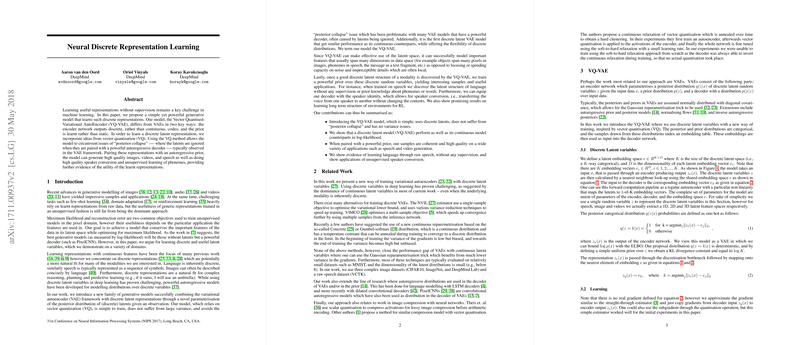Neural Discrete Representation Learning
The paper "Neural Discrete Representation Learning" by Aaron van den Oord, Oriol Vinyals, and Koray Kavukcuoglu from DeepMind presents the Vector Quantised-Variational AutoEncoder (VQ-VAE), a novel generative model that effectively learns discrete representations. This model addresses long-standing challenges in variational autoencoders (VAEs), particularly "posterior collapse," by leveraging vector quantisation (VQ) and autoregressive priors, producing high-quality samples across multiple domains including images, videos, and audio.
The VQ-VAE is characterized by two main design choices: the encoder outputs discrete latent codes instead of continuous ones, and the prior distribution is learned rather than static. These design choices are pivotal as they allow the model to manage the trade-off between capturing rich latent representations and maintaining stable training dynamics, especially when paired with powerful decoders like PixelCNN and WaveNet.
Key Contributions and Methodology
- Model Architecture: The VQ-VAE employs vector quantisation to map the encoder outputs to fixed discrete points in an embedding space. This prevents the latent variables from collapsing into non-informative values, a common issue in traditional VAEs with powerful decoders. The discrete latent variables, paired with an autoregressive prior, enable the model to generate coherent and high-quality outputs.
- Training Stability: The training uses a commitment loss to ensure that the encoder outputs conform to the fixed points in the embedding space, and an exponential moving average (EMA) technique to update the embedding vectors, ensuring stable and efficient learning without large variance issues seen in other methods.
- Experimental Validation: The authors demonstrate the capability of VQ-VAE across different data modalities:
- Images: Training on CIFAR10, ImageNet, and DeepMind Lab datasets showed that VQ-VAE could effectively reconstruct and generate images. The discrete latent space facilitated a significant reduction in data dimensionality while preserving crucial features.
- Audio: Experiments on the VCTK and LibriSpeech datasets illustrated that VQ-VAE could successfully extract high-level discrete speech features, enabling applications like unsupervised phoneme discovery and speaker conversion.
- Video: Training on action-conditioned sequences from the DeepMind Lab environment showcased the VQ-VAE’s ability to model long-term dependencies and generate successive frames conditioned on actions, highlighting its potential for tasks requiring coherent temporal progression.
Strong Numerical Results
The paper reports competitive likelihoods of 4.67 bits/dim for the VQ-VAE on CIFAR10, comparable to continuous VAE counterparts (4.51 bits/dim) and significantly better than VIMCO (5.14 bits/dim). These results underscore the model’s efficacy in capturing data distributions efficiently with discrete latent variables. Such quantitative evidence strongly supports the robustness and versatility of the VQ-VAE.
Implications and Future Directions
The practical implications of this research are significant. By demonstrating how discrete latent spaces can be utilized effectively in various domains, the VQ-VAE provides a foundational framework for future developments in unsupervised learning:
- LLMs: The ability of the VQ-VAE to model phoneme-level language representations without supervision opens new avenues for natural language processing tasks, particularly in low-resource settings.
- Data Compression and Transmission: The discrete latent representations lend themselves to efficient data compression techniques, which could be crucial for resource-constrained environments like edge computing and IoT.
- Reinforcement Learning: The demonstrated capability to model long-term dependencies in action-conditioned videos suggests applications in reinforcement learning, where understanding temporal sequences is crucial.
Future research could explore joint training of the prior and VQ-VAE components to potentially enhance performance further. Additionally, investigating alternative embedding strategies and scaling the model to even more complex datasets could provide deeper insights and broaden its applicability.
In conclusion, the VQ-VAE represents a substantial step forward in the development of generative models with discrete latent variables. Its design aligns well with the need for robust, scalable, and interpretable representations across diverse data modalities.
